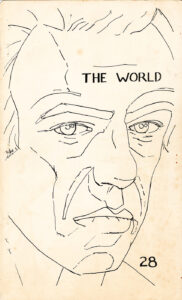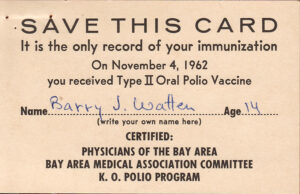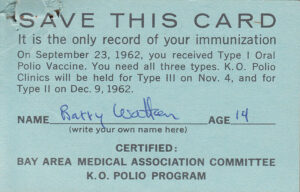 I return to the vexed question of autobiography, which in earlier times I believed one should “start writing” only when all other options—of world transformation, for instance—had failed. The two key terms are brought together in the 1973 cover of The World 28, the “Autobiography Issue” edited by Lewis Warsh. As I recalled when Lewis died late last year, I first met him in Mendocino, on his way down the coast to Bolinas, where I visited him before he moved back east. In his editing of The World, he wanted to radicalize autobiography not as a genre but as a mode of writing. Writing from an immediate perspective of “personhood” in any genre was of interest, from poetry to fiction to memoir, journal entries, letters, portraits, and snapshots.
I return to the vexed question of autobiography, which in earlier times I believed one should “start writing” only when all other options—of world transformation, for instance—had failed. The two key terms are brought together in the 1973 cover of The World 28, the “Autobiography Issue” edited by Lewis Warsh. As I recalled when Lewis died late last year, I first met him in Mendocino, on his way down the coast to Bolinas, where I visited him before he moved back east. In his editing of The World, he wanted to radicalize autobiography not as a genre but as a mode of writing. Writing from an immediate perspective of “personhood” in any genre was of interest, from poetry to fiction to memoir, journal entries, letters, portraits, and snapshots.
Autobiography would be the royal road to writing per se; there was a tradition and consensus that “self/life/writing” was what there was to do, in fact was all that could be done. For a brief while there was in fact a kind of period style of autobiographical self-discovery, nothing like the persona poems of the workshop but evoking a tradition from Rousseau and the romantics, Zukofsky’s “the words are my life,” Beat spontaneity, and New York School everyday life. The consensus—and it was not long lived—was that “into the company of self it all returns,” one might say. Warsh’s 1973 project, bringing together writers of several diverse schools, was the highpoint of that moment.
I was the early Language writer in that group, in company with Clark Coolidge, Bernadette Mayer, Tom Raworth, Bobbie Louise Hawkins, Bill Berkson, Anne Waldman, all poets who would appear in the first issues of This, but also Diane Di Prima, Kenward Elmslie, Lee Harwood, Harris Schiff, and John Wieners. The issue should be reprinted in its entirety, to reflect on the question of writing that Lewis proposed: where the fact of writing and the events of life are seen as nearly identical. What historical circumstances obtained for that to be possible, desirable, likely? But there is also a moment of transition here: from person to language—at one pole the iconic representation of personhood, in condensed and presentable form, and on the other the endlessness of scribbling in letters and journals, a fascination of writing per se. … More














